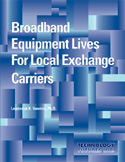Broadband Equipment Lives for Local Exchange Carriers
[ordering online? -- please see our return/refund policy]

Description
Sampling of Key Findings
Who Should Read this Report?
Table of Contents
Figures and Featured Graphs
Pricing/Ordering information
Sponsored by TTFG
Technology Futures forecasts continued increases in broadband speeds, hastening the obsolescence of broadband investment. Broadband Equipment Lives for Local Exchange Carriers presents recommendations for depreciation lives for broadband equipment such as video set-top boxes, headend equipment, and broadband loop electronics, including DSLAMs, DSL modems, and BPON equipment. Discussing the report, author Dr. Vanston states, "The business of incumbent local exchange carriers (ILECs) is transitioning from primarily voice to primarily high-speed broadband and video. This means that equipment devoted to delivering broadband and video will come to dominate the useful investment of ILECs. Much of this equipment is significantly different than traditional narrowband equipment and, thus, may have different depreciation lives."
A Sampling of Key Findings [back to top]
- The required data rate for broadband is increasing rapidly, causing rapid obsolescence of broadband equipment. By 2010, about 75% of U.S. households will have broadband service, and over 15% of households will subscribe to very high-speed broadband (at least 24 Mb/s). See Featured Graph: Broadband Households by Nominal Date Rate.
- New video services such as IP video, Internet television, and HDTV are rapidly being adopted and improved. This will cause significant obsolescence of broadband equipment.
- The broadband, voice, and video networks are moving toward the IP paradigm, meaning less expensive equipment, rapid obsolescence, and marked volatility in applications, services, and network requirements.
- In each of the broadband architectures currently being deployed, significant amounts of active electronics are exposed to the elements (either on the side of a house or at a remote node) or to household activity. This will reduce depreciation lives.
The study recommends Average Remaining Lives (ARLs) and a P-Life range for each of the following equipment categories:
- Standard DSL Equipment: DSLAMs & DSL Modems
- VDSL Equipment: VDSLAMs & VDSL Modems
- BPON Equipment: OLTs & ONTs
- Broadband Switching & Video Equipment
- Set-top Boxes
Who Should Read this Report? [back to top]
- Incumbent local exchange carriers
- Competitive LECs
- Cable TV companies
- Internet service providers
- Telecom equipment manufacturers
- Regulatory personnel
- Depreciation professionals
- Property tax professionals.
Table of Contents [back to top]
- Chapter 1: Introduction and Summary
- Chapter 2: Broadband Access Forecasts
- Chapter 3: Standard DSL Equipment
- Chapter 4: Very-High-Speed DSL Equipment
- Chapter 5: Broadband Passive Optical Network Equipment
- Chapter 6: Broadband Switching and Video Headend and Distribution Equipment
- Chapter 7: Set-Top Boxes
List of Figures with Featured Graph [back to top]
2.1 Broadband Households, Percentage of Households 2.2 Adoption of Various Consumer Communications Products and Services 2.3 Broadband Households by Nominal Data Rate, Percentage of Households (excludes Cable Modems) 2.4 Trend in Residential Access Data Rates 2.5 Forecast Adoption of Standard and Very-High-Speed Broadband, Percentage of Households 2.6 Minimum Availability of Very-High-Speed Broadband 2.7 Scenarios for ILEC Distribution Fiber 2.8 Middle Scenario compared to VHS Broadband Availability 2.9 Broadband Households Using Online Video at Least Once a Month 2.10 Broadband Households Using Online Television at Least Once a Week 2.11 HDTV Households 2.12 Internet HDTV Households 2.13 Comparison of Internet HDTV and VHS Broadband Households 3.1 Forecast Adoption of Standard and Very-High-Speed Broadband 3.2 Standard DSL Modem Life-Cycle assuming VHS Substitution Only (FTTN & FTTC Deployment) 3.3 Minimum Availability of Very-High-Speed Broadband 3.4 Standard DSLAM Life-Cycle assuming VHS Substitution Only 3.5 Standard DSLAM Survivors assuming Combined Technology Substitution and Mortality Forces 3.6 Standard DSL Modem Survivors assuming Combined Technology Substitution and Mortality FTTN & FTTC 3.7 Standard DSL Modem Survivors assuming Combined Technology Substitution and Mortality FTTP 3.8 Standard DSL Modem Survivors 1999 Vintage (Assuming FTTP Deployment) 3.9 Standard DSL Modem Survivors 2009 Vintage (Assuming FTTP Deployment 3.10 Standard DSL Modem Additions by Year Assuming FTTP Deployment 3.11 Price Trend for DSLAMs 4.1 Scenarios for the Adoption of Distribution Fiber 4.2 VDSL Modem Life Cycle assuming FTTP Substitution Only 4.3 VDSLAM Life Cycle Assuming FTTP Substitution Only 4.4 VDSLAM Survivors assuming Combined Technology Substitution and Mortality Forces 4.5 VDSL Modem Survivors assuming Combined Technology Substitution and Mortality 4.6 VDSL Modem Survivors 2010 Vintage 4.7 VDSL Modem Additions by Year 4.8 VDSLAM Vintage Survivor Curves 5.1 Evolving Data Rate Availability Requirements 5.2 BPON Equipment Life Cycle assuming Technology Substitution Only 5.3 BPON OLT Survivors assuming Combined Technology Substitution and Mortality Forces 5.4 BPON ONT Survivors assuming Combined Technology Substitution and Mortality 5.5 BPON ONT Survivors 2010 Vintage 5.6 BPON ONT Additions by Year 5.7 BPON OLT Vintage Survivor Curves 6.1 Average Access Data Rate 6.2 Price and Capacity Requirement Trends 6.3 Three-Year Lifetime Capacity Requirement 6.4 Equipment Capacities Assuming Three-Year Life 6.5 Equipment Cost Assuming Three-Year Life 6.6 Equipment Cost vs. Planned Life 6.7 Annualized Cost vs. Planned Life (No Installation Cost) 6.8 Installed Cost vs Planned Life (Installation Cost = 600) 6.9 Annualized Cost vs. Planned Life (Installation Cost=600) 6.10 Annualized Cost vs. Planned Life (Various Installation Costs) 7.1 Installed Base of Basic and Advanced Digital Set-top Boxes 7.2 Basic Digital Set-top Box Survivors and Life Cycle assuming Advanced STB Substitution Only 7.3 Basic Digital Set-top Box Survivors assuming Combined Technology Substitution and Mortality Forces 7.4 Basic Digital Set-Top Box Survivors 1998 Vintage 7.5 Basic Digital Set-Top Box Survivors 2007 Vintage 7.6 Basic Digital Set-Top Box Additions by Year 7.7 Internet Set-Top Box Percentage of Installed Base Compared with Key Video Adoptions 7.8 Installed Base of ILEC First Generation and Internet Set-Top Boxes 7.9 ILEC First Generation Set-Top Box Survivors assuming Combined Technology Substitution and Mortality Forces 7.10 ILEC First Generation Set-Top Box Additions by Year
Pricing/Ordering Information [back to top]
August 2007, 74 pages, ISBN 18-84154-2-98
Sponsored by the TTFG

